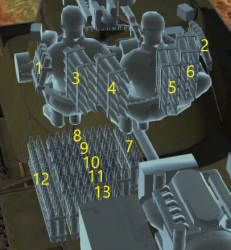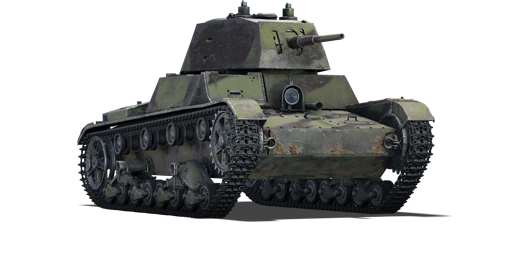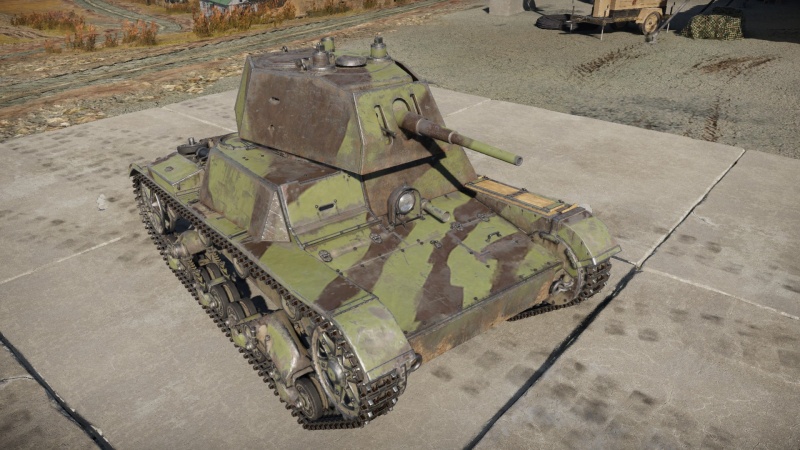T-26E
| This page is about the Soviet light tank T-26E. For other variants, see T-26 (Family). |
Contents
Description
The T-26E is a premium gift rank I Soviet light tank with a battle rating of 1.3 (AB/RB/SB). It was introduced as a premium pack during the Closed Beta Test for Ground Forces before Update 1.41. It was removed from the store after the 2017 Victory Day sale but was reintroduced in April 2019 as a battle trophy vehicle in the Warbond shop. As an up-armoured version of the T-26, it stands a better chance deflecting enemy shells off its front armour when angled correctly.
General info
Survivability and armour
The armour of the T-26E is greatly improved over the base model with add-on 30mm armour plates on the hull and turret on all sides. Despite being poorly angled, this armour, when not angling the hull, is very much immune to early cannons with low penetration (eg. 37mm Type 94, 37mm SA18 L/21), and when angling the hull, is capable of deflecting some of the most lethal rounds at this BR such as the infamous 20mm PzGr.40 round used by the Pz.II C. This allows the T-26E to be more of a frontline "heavy" tank. However, the armour is still very weak against tank destroyer guns like the 47mm Pak.(t)(Sf.) so be very careful if one is present around you. Also the add-on armour only covers the upper plates, leaving the lower front plate unprotected. The transmission is often damaged for this reason. Do note that the armor is welded practically flat to the outside of the original armor and is not spaced, meaning that this armor will not stop HEAT rounds from penetrating.
The crew are not lined up behind each other from the front, meaning that enemies using shells without HE filler may have to take up to 2-3 shots before knocking out all of your crew. The tank's interior is very cramped, so a shell with HE filler will easily knock out a crew or other component. T-26s in general should not be taking the brunt of enemy fire.
Armour type:
- Rolled homogeneous armour
| Armour | Front | Sides | Rear | Roof |
|---|---|---|---|---|
| Hull | 30 + 15 mm (22°) Front plate 7 mm (64-80°) Front glacis 15 mm (6-52°) Lower glacis |
30 + 15 mm (24-25°) Top 15 mm (0°) Bottom |
30 + 15 mm (1°) Top 30 + 15 mm (12°) Bottom |
6 mm |
| Turret | 30 + 15 mm (12-33°) Turret front 30 + 15 mm (5-44°) Gun mantlet |
30 + 15 mm (17-19°) | 30 + 15 mm (17°) | 10 mm |
Notes:
- Suspension wheel are 10 mm thick while tracks are 15 mm thick.
- The 30 mm applique armour does not cover the entire area on the hull, so there are exposed areas vulnerable to enemy fire.
Mobility
| Game Mode | Max Speed (km/h) | Weight (tons) | Engine power (horsepower) | Power-to-weight ratio (hp/ton) | |||
|---|---|---|---|---|---|---|---|
| Forward | Reverse | Stock | Upgraded | Stock | Upgraded | ||
| Arcade | 34 | 4 | 12 | 141 | 174 | 11.75 | 14.5 |
| Realistic | 31 | 4 | 80 | 91 | 6.67 | 7.58 | |
While being a light tank, its mobility is one of a medium/heavy tank. The top speed is very low for a light tank, combined with the low power to weight ratio given by its weak engine. The T-26E has poor acceleration and speed on most surfaces. It can reach around 30 km/h only on hard, flat surface, after a long, uninterrupted acceleration period. With even a small turn the speed will drop significantly. The narrow tracks significantly reduce its off-road mobility in muddy, sandy or snowy maps. Despite the tracks being short and far apart, the T-26E still has slow hull traverse and often needs a forward/backward jerk to start turning properly. Reverse speed is also very poor (-4 km/h), which cannot save you from most bad situations. Despite these drawbacks, it will eventually take you where you want to be, provided that you are a very patient player, choose your route well, and avoid too many tricky turns.
Modifications and economy
Armaments
Main armament
| 45 mm 20-K | Turret rotation speed (°/s) | Reloading rate (seconds) | |||||||||||
|---|---|---|---|---|---|---|---|---|---|---|---|---|---|
| Mode | Capacity | Vertical | Horizontal | Stabilizer | Stock | Upgraded | Full | Expert | Aced | Stock | Full | Expert | Aced |
| Arcade | 205 | -6°/+22° | ±180° | N/A | 15.23 | 21.08 | 25.60 | 28.31 | 30.12 | 3.77 | 3.34 | 3.07 | 2.90 |
| Realistic | 9.52 | 11.20 | 13.60 | 15.04 | 16.00 | ||||||||
Ammunition
| Penetration statistics | |||||||
|---|---|---|---|---|---|---|---|
| Ammunition | Type of warhead |
Penetration @ 0° Angle of Attack (mm) | |||||
| 10 m | 100 m | 500 m | 1,000 m | 1,500 m | 2,000 m | ||
| BR-240 | APHEBC | 70 | 68 | 59 | 50 | 42 | 35 |
| BR-240SP | AP | 73 | 71 | 62 | 52 | 44 | 37 |
| Shell details | |||||||||
|---|---|---|---|---|---|---|---|---|---|
| Ammunition | Type of warhead |
Velocity (m/s) |
Projectile Mass (kg) |
Fuse delay (m) |
Fuse sensitivity (mm) |
Explosive Mass (TNT equivalent) (g) |
Ricochet | ||
| 0% | 50% | 100% | |||||||
| BR-240 | APHEBC | 760 | 1.43 | 1.2 | 9 | 29.26 | 48° | 63° | 71° |
| BR-240SP | AP | 757 | 1.43 | N/A | N/A | N/A | 47° | 60° | 65° |
Ammo racks

| Full ammo |
1st rack empty |
2nd rack empty |
3rd rack empty |
4th rack empty |
5th rack empty |
6th rack empty |
7th rack empty |
|---|---|---|---|---|---|---|---|
| 205 | 202 (+3) | 197 (+8) | 187 (+18) | 177 (+28) | 167 (+38) | 157 (+48) | 139 (+66) |
| 8th rack empty |
9th rack empty |
10th rack empty |
11th rack empty |
12th rack empty |
13th rack empty |
Visual discrepancy |
|
| 121 (+84) | 103 (+102) | 79 (+126) | 61 (+144) | 29 (+176) | 1 (+204) | No |
Note:
- Turret empty: 157 (+48) shells.
Machine guns
| 7.62 mm DT | ||||
|---|---|---|---|---|
| Mount | Capacity (Belt) | Fire rate | Vertical | Horizontal |
| Coaxial | 1,890 (63) | 600 | N/A | N/A |
Usage in battles
One of the main tactics of the T-26E is taking hull-down positions. Using this strategy, when a close friendly player is attacked by an enemy, go behind a rock, other solid object, or entrenchment that covers your hull, and get ready to shoot at targets.
- If the enemy is a tank destroyer like the StuG III A, you can shoot its tracks to make it immobile and then flak it to penetrate the thin side and rear armor. Most tank destroyers at this BR will be very susceptible to this form of attack.
- If the enemy is a medium or heavy tank (like the Neubaufahrzeug), you can shoot its horizontal turret drive so it cannot move it's turret (The ring below its turret), then shoot the tracks to immobilize it, moving to shoot through the sides or rear. Beware that if the shell does not damage the gun breech of a vehicle (and in the case of the Neubaufahrzeug, it has two), it could potentially still fire back by rotating its hull.
Due to the top speed of the T-26E being less than many other vehicles at its BR (30 km/h), it will usually arrive in the battlefield after the fighting has already begun. This can be an advantage in that you arrive after your team has already identified many targets. This also means that you will most likely not be on the front line of attack will usually allows for you to last a bit longer than players who rushed the center of the battlefield. On the other hand, it is also less likely that you will reach capture points before they are capped by your teammates, who will be faster than you.
Apart from the low speed, the T-26E also offers great firepower and nice protection. The 45 mm cannon can frontally penetrate and one-shot most tanks at this BR: very beginner friendly. Although lacking any stabilizer, the T-26E is still quite a stable gun platform. The add-on armour provides better protection against the popular 20 mm autocannon. Especially when the T-26E is angling, the autocannons' APCR penetration will be greatly reduced.
Pros and cons
Pros:
- Great firepower; the stock APHE shell has 70 mm maximum penetration and 32g TNT which can frontally penetrate and one-shot many tanks it will face
- Very fast reload
- Fairly accurate gun at short to medium ranges
- Massive ammo capacity and fast reload time which is good for new players learning how to manoeuvre and fire
- Effective coaxial machine gun for use against open-topped enemy vehicles and trucks
- Tough turret armor for the tier
Cons:
- Low lower hull armour
- A weak spot in the hull box, the driver's hatch - keep this away from enemy fire
- Poor overall mobility; low top speed, very low reverse speed, slow hull traverse, and difficulty in climbing steep slopes
- Three crew members packed tightly together significantly reduces survivability
- Average -5° gun depression limits its potential in hilly terrains
- Easily distinguishable Standard camouflage & shape
History
Development
The T-26 light tank in Soviet service, while making up a major part of the Soviet armoured forces, proved quite under-armoured when against newer anti-tank weapons as it was an old 1931 design. The Spanish Civil War showed some of these defects in the T-26, but it wasn't until the Winter War against Finland that proved that the majority of light anti-tank weapons could destroy the T-26.
In order to remedy this, Factory No. 174 in Leningrad designed a new variant for the T-26 utilizing applique armour on the hull and turret. This variant was dubbed the T-26E (E for ekranirovanny or "screened"), which added 30-40 mm of armour to the original armour plates via bolting and welding. All of the single-turreted T-26 models made during the Winter War period was given this modification and testings proved that the additional armour made the T-26 much more resilient against light anti-tank weapons. A total of 89 T-26Es were made during and after the Winter War, with 27 single-turret models made from the factory, 27 more as flamethrower-models, and 15 single-turret models were made in workshops near the front-line. After the war, 20 more single-turret variants were made and delivered for tank units. Many more modified T-26s were made during the course of World War II.
Combat usage
These T-26Es were used in the Winter War against Finland and the extra armour over the normal T-26 variants made it impenetrable to Finnish light anti-tank weapons. However, the extra armour added to the T-26 raised the weight from 9.6 tons to 12 tons, thus a larger strain on the chassis, engine, and suspension so the driver was advised to drive the tank in low gear and must take extra care to not overload these systems.
During World War II, applique armour of varying thickness from 15–40 mm was added onto many different T-26s in large quantities ranging to hundreds in the front-lines to fight back the German invasion. Such areas where these modifications took place in Leningrad, Odessa, Moscow, and Sevastopol in the period of 1941–1942 during battles and sieges taking place in or near these cities. However, compared to the modifications made during the Winter War, the World War II T-26Es were more crude and rough that the gun mask on the tank was unable to move, and the applique armour was only added on the front.
No known combat records exist for these modified T-26s in World War II and may have been simply been added as performances done by regular T-26s, but due to the obsolesce of the T-26 models compared to the German Panzer III and Panzer IV, many can be presumed to be lost in combat if not due to mechanical failures.
In-game description
The Spanish Civil War showed that the T-26 tank's armour no longer protected it from new low-calibre anti-tank weapons. So in 1937-1938, strengthening the tank's armour became an immediate concern. Designers at factory No. 174 decided to simply introduce a conical-shaped turret and to slope the armour plates on the underturret box. The armour's thickness remained unchanged, as the undercarriage structure, already pushed to its limits as it was, prevented the tank's mass from being increased. The issue of increasing the light tank's armour became a prominent concern again by the Winter War beginning on 30 November 1939.
The first battles showed that Finland's anti-tank weapons easily destroyed the tanks. On the 20th of December, work began on up-armouring T-26 tanks with 30-40 mm thick armour plates at factory No. 174. On 30 December 1939, firing tests were carried out on the first up-armoured T-26 at the factory's ballistic range, with positive results. The vehicle withstood fire from a 45 mm anti-tank cannon at a distance of 400-500 m.
Having successfully passed testing, the up-armoured design was accepted as a success and the Leningrad Kirovsk factory equipped around 70 tanks with the additional armour. The additional armour was attached to the turret, underturret box, side and front of the tank with screw rivets and electric arc welds. The gun mantlet was also up-armoured. The tank's mass increased to 12 tonnes, which meant the engine and suspension were overloaded. The tank could now only move in low gear and had an increased risk of breaking down.
T-26Es were used at the beginning of the Great Patriotic War. Several vehicles remained in service on the Leningrad front until 1943. Captured light tanks of this type were used by the Wehrmacht and Waffen SS in 1941-1942.
Media
- Skins
- Videos
See also
Links to the articles on the War Thunder Wiki that you think will be useful for the reader, for example:
- reference to the series of the vehicles;
- links to approximate analogues of other nations and research trees.
External links
Paste links to sources and external resources, such as:
- topic on the official game forum;
- other literature.
| USSR light tanks | |
|---|---|
| T-26 | T-26 · T-26 (1st Gv.T.Br.) · T-26-4 · T-26E |
| BT | BT-5 · RBT-5 · BT-7 · BT-7 TD · BT-7M · BT-7A (F-32) |
| T-50 | T-126 · T-50 |
| T-70 | T-70 · T-80 |
| PT-76 | PT-76B · PT-76-57 · Object 906 |
| BMP | BMP-1 · BMP-2 · BMP-2M · BMP-3 |
| BMD | BMD-4 |
| 2S25 | 2S25 · 2S25M |
| Wheeled | BA-11 · BTR-80A |
| Other | T-60 · Object 685 · 2S38 |
| China | ▂Type 62 |
| USSR premium ground vehicles | |
|---|---|
| Light tanks | BA-11 · RBT-5 · BT-7A (F-32) · T-26 (1st Gv.T.Br.) · T-26E · T-126 · PT-76-57 · 2S38 |
| Medium tanks | T-34 (Prototype) · T-34 (1st Gv.T.Br.) · T-34E · T-34-57 (1943) · T-34-85E · T-34-100 · T-44-122 · TO-55 · T-55AM-1 · T-72AV (TURMS-T) · T-80UD |
| ▂M3 Medium · ▂M4A2 · ▂T-III · ▂T-V · ▂МК-IX "Valentine" | |
| Heavy tanks | SMK · T-35 · ▂MK-II "Matilda" · KV-1E · KV-2 (1940) · KV-2 (ZiS-6) · KV-122 · KV-220 · IS-2 "Revenge" · Object 248 · IS-6 · T-10A |
| Tank destroyers | BM-8-24 · BM-13N · BM-31-12 |
| SU-57 · SU-76D · SU-76M (5th Gv.Kav.Corps) · SU-85A · SU-100Y · SU-122P · Object 120 | |
| SPAA | ▂Phòng không T-34 · ZUT-37 |





